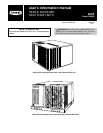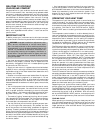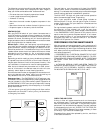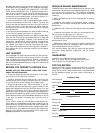
WELCOME TO EFFICIENT
YEAR-ROUND COMFORT
Congratulations on your excellent choice and sound invest-
ment in home comfort! Your new heat pump represents both
the latest in engineering development and the culmination
of many years of experience from one of the most reputable
manufacturers of comfort systems. Your new unit is among
the most reliable home comfort products available today. To
assure its dependability, spend just a few minutes with this
booklet now. Learn about the operation of your heat pump
and the small amount of maintenance it takes to keep it op-
erating at its peak efficiency.
With minimal care, your heat pump will provide you and your
family with dependable home comfort — both now and for
years to come.
IMPORTANT FACTS
To better protect your investment and to eliminate unneces-
sary service calls, familiarize yourself with the following facts:
WARNING:
Improper installation, adjustment, alter-
ation, service, maintenance, or use can cause explo-
sion, fire, electrical shock, or other conditions which may
cause personal injury or property damage. Refer to this
manual. For assistance or additional information con-
sult a qualified installer, service agency, distributor, or
branch office. The qualified installer or agency must use
only factory authorized kits or accessories when modi-
fying this product.
• Your heat pump system should never be operated without
a clean air filter properly installed. Plan to inspect the filter
periodically. A clogged air filter will increase operating costs
and shorten the life of the unit.
• Supply-air and return-air registers should not be blocked.
Drapes, furniture, and toys are some of the items commonly
found obstructing grilles. Restricted airflow lessens the unit’s
efficiency and life span.
• Outdoor units must have unrestricted airflow. Do not cover
the unit, lean anything against it, or stand upon it. Do not
allow grass clippings, leaves, or other debris to accumulate
around or on top of the unit. Maintain a 12-inch minimum
clearance between the outdoor unit andtall grass,vines, shrubs,
et cetera.
• Your multipurpose indoor thermostat is the control center
for your heat pump system. You should familiarize yourself
with its proper operation. Attempting to control the system
by other means — for instance, switching the electrical sup-
ply power ON and OFF — may cause damage to the unit.
• Thermostat ‘‘jiggling’’ causes rapid-cycling, which is poten-
tially damaging to the compressor. Do not move the tempera-
ture selector on the thermostat for any reason for at least
5 minutes after the compressor has shut off.
• You may find that you can maintain greater personal com-
fort by running the fan continuously. ‘‘Air pockets’’ can form
due to the structure of the building, placement of registers,
et cetera. These air pockets may be too cool or warm for your
liking. Continuous fan operation minimizes any temperature
differences. Also, systems equipped with electronic air clean-
ers and/or humidifiers offer the added benefits of having the
air continuously cleaned year-round, and humidified during
the winter season.
• Your heat pump will remove humidity from your home dur-
ing the cooling season. After a few minutes of operation, you
should be able to see water trickle from the condensate drain.
Check this occasionally to be sure the drain system is not
clogged. Of course, don’t expect to see much drainage if you
live in a very dry climate.
OPERATING YOUR HEAT PUMP
The operation of your heat pump system is controlled by the
indoor thermostat. You simply adjust the thermostat and it
maintains the indoor temperature at the level you select. Most
thermostats for heat pump systems include temperature con-
trol selector, FAN switch, and SYSTEM switch. EMER-
GENCY HEAT control is usually provided with the SYSTEM
switch.
Thetemperaturecontrolselectorisadial or button(s) thatal-
lowsyoutoestablishthetemperaturethatyouwishtomain-
tain for your personal comfort. Some thermostats possess two
temperature control selectors: one for setting the tempera-
ture desired during the cooling cycle, and one to set the heat-
ing operation temperature. Typical settings are 78 degrees
Fahrenheit for cooling and 68 degrees for heating.
The FAN switch offers two options for controlling the blower:
AUTO and ON. When set to AUTO, the blower will run dur-
ing the time the heat pump is operating. When the FAN switch
is set at the ON position, the blower will run continuously.
Typically, the SYSTEM switch on your thermostat offers the
following selections: COOL, OFF, and HEAT. Your thermo-
stat may also have a another selection,AUTO. The heat pump
will not operate when the SYSTEM switch is set at the OFF
position. With the SYSTEM switch set at COOL, your heat
pump will operate in its cooling mode when the indoor tem-
perature rises above the level that you wish to maintain. With
the SYSTEM switch set at the HEAT position, your heat pump
will provide warmth whenever the indoor temperature falls
below the level that you have selected.
The AUTO selection found on some thermostats provides for
automatic changeover between cooling and heating cycles. With
the SYSTEM switch set in the AUTO position, the cooling
mode is activated when the indoor temperature rises above
the thermostat cooling temperature setting, or the heating
mode will be activated when the indoor temperature drops
below the thermostat setting for the heating cycle.
Depending on your typical winter heating needs, your home
comfort system may include a supplementary heating source.
The EMERGENCY HEAT switch provides for convenient se-
lection between two heating modes. Your heat pump will op-
erate when the switch is set at NORMAL. With the switch
set at the EMERGENCY HEAT position, the heat pump will
turn off and the supplementary heat source will be activated.
COOLING CYCLE
When operating in the cooling cycle, your heat pump will run
until the indoor temperature is lowered to the level you have
selected. On extremely hot days, your heat pump will run for
longer periods at a time and have shorter ‘‘off’’ periods than
on moderate days.
—2—






